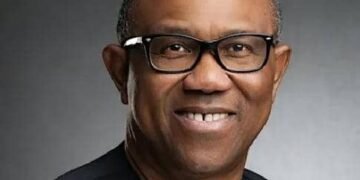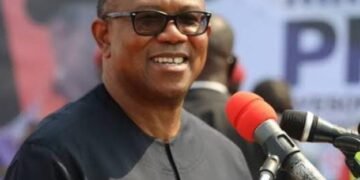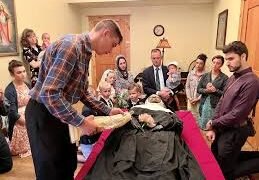Valentine Obienyem
I read today about the meeting between Pope Leo XIV and the Ecumenical Patriarch of Constantinople, His All-Holiness Bartholomew I yesterday, the 19th. The encounter immediately reminded me of a past that ought to be reconciled -the Great Schism. Schism – division – is among the gravest wounds to the unity Christ envisioned for His Church. The history of these divisions is long and complex, often entangled with theological disputes, cultural shifts, and political ambitions. In later centuries, matrimonial contentions, particularly surrounding divorce, also came into play.
The Great Schism of 1054, which formally divided Christianity into the Roman Catholic Church in the West and the Eastern Orthodox Church in the East, is perhaps the most enduring example. This schism was not merely a matter of doctrinal disagreement but reflected the divergent paths of Eastern and Western civilisation.
The disputes that culminated in the schism were multifaceted. One major issue was the “Filioque” clause; another was the question of the primacy of Rome over all churches, which the Eastern patriarchs rejected. These theological differences were compounded by political rivalries, linguistic barriers, and distinct liturgical traditions. The mutual excommunications of 1054, between Pope Leo IX and Patriarch Michael Cerularius, symbolised a painful rupture that would endure for centuries.
Yet history is not static but a continuous unfolding of human hope and effort. The lifting of these excommunications in 1965 by Pope Paul VI and Patriarch Athenagoras I was more than a symbolic gesture – it was an affirmation that even ancient wounds can begin to heal through dialogue and humility. This encounter opened a new chapter, one in which centuries-old antagonism gave way to cautious friendship and collaboration. Since then, both subsequent Popes and Patriarchs have been meeting.
This commitment to unity has been evident through many demonstrations. The Second Vatican Council (1962–1965), particularly through its decree “Unitatis Redintegratio” (“The Restoration of Unity”), marked a turning point in the Catholic Church’s approach to other Christian communities. It recognised that elements of sanctification and truth exist outside the visible boundaries of the Catholic Church and called for fraternal dialogue, theological cooperation, and mutual respect.
Following the Council, Pope John Paul II deepened this effort with a series of powerful encyclicals. His 1995 encyclical “Ut Unum Sint” (“That They May Be One”) affirmed that ecumenism is not optional but “an imperative of the Christian conscience.” In it, he acknowledged the painful historical divisions but insisted that unity could not come at the cost of truth. In a gesture of openness, he even invited discussion on the nature of papal primacy – long a point of contention between East and West.
That same year, in “Orientale Lumen” (“The Light of the East”), he offered a profound appreciation of the Eastern Christian spiritual and theological tradition. He praised the Eastern Orthodox Churches for their liturgical richness, their monastic heritage, and their theological depth, urging Catholics to learn from and walk with their Eastern brethren. “The Church must breathe with her two lungs,” he famously said – East and West together forming the full body of Christ’s presence in the world.
The image of Pope Leo XIV meeting His All-Holiness Bartholomew I, the Ecumenical Patriarch of Constantinople, echoes this hopeful spirit. It is a vivid reminder that the Church’s deepest divisions are not insurmountable. Both Churches, while separated by ecclesial structures and minor doctrinal differences, share a common apostolic foundation. Their apostolic succession, sacramental life, and theological heritage are threads woven from the same sacred tapestry, despite the rift.
The Ecumenical Patriarch of Constantinople, formally titled Archbishop of Constantinople, New Rome, and Ecumenical Patriarch, is the spiritual leader of the Eastern Orthodox Church. While he holds the status of “first among equals” among the bishops of Eastern Orthodoxy, he has no direct jurisdictional control over the other churches theologically known as “autocephalous” (self-governing) Orthodox Churches. His authority is moral and symbolic, aimed at promoting unity, coordinating inter-Orthodox dialogue, and serving as a point of contact with other Christian traditions.
History teaches us that no cultural or religious tradition exists in a vacuum. Civilisations grow not merely through internal development, but through encounter, through the cross-pollination of ideas, beliefs, and practices. For centuries, the Christian East and West have shaped, challenged, and enriched one another, often in tension, yet always in dialogue, whether implicit or overt.
Yesterday’s meeting between the Pope and the Ecumenical Patriarch transcends the bounds of a mere ecclesiastical event; it is a profound act of cultural and spiritual engagement. It symbolises a renewed willingness to confront the divisions forged by centuries of theological dispute, linguistic divergence, and geopolitical rivalry. More than a ceremonial gesture, it is a living testament to the enduring hope for unity – not uniformity, but communion amid diversity. In their encounter, East and West rediscover not only one another, but also deeper dimensions of their shared apostolic roots
While the 23 Eastern Catholic Churches remain in full communion with Rome, the Orthodox Churches under the Ecumenical Patriarchate are not yet reconciled with the Rome. This reconciliation is my personal assignment for Pope Leo. We need in the Church that unity Christ prayed for, a unity rooted in truth, charity, and mutual respect.
Beyond the historic divide with the Orthodox East lies the even more intricate and far-reaching reality of the Protestant Reformation – a watershed moment in the history of Christianity. Emerging in the 16th century, it was, as some have observed, Martin Luther hatching the eggs laid by Erasmus: a movement that began as a call for reform but quickly evolved into a profound rupture with the Roman Catholic Church.
The Reformation challenged a wide array of Catholic doctrines and practices, giving rise to a constellation of Christian communities, each with its own theological emphases, liturgical expressions, and ecclesial identities. From a Catholic standpoint, many of these doctrinal departures are regarded as heresies – breaks from the apostolic tradition. How may a new unity be attained? Is it possible?
Ecumenism is not a compromise or a watering down of doctrine but an ongoing quest, fraught with difficulty but guided by the Spirit, to recover the unity that makes the Church a true reflection of Christ’s body. As “Unitatis Redintegratio” reminds us, “Nothing is so foreign to the spirit of ecumenism as a false irenicism.”
In this light, the meeting between Pope Leo XIV and Patriarch Bartholomew is far more than a moment suspended in time; it is a living testament to the enduring hope for Christian unity. It stands as a quiet yet powerful summons to patience in the face of centuries-old wounds, to sincere and sustained dialogue amid enduring differences, and above all, to hope – hope that the fractured Body of Christ might one day be healed through charity, humility, and the grace of mutual understanding. May we all, moved by this encounter, commit ourselves in prayer and action to the restoration of the unity once shared in the first millennium – not by erasing the richness of our diverse traditions, but by embracing them within the fullness of the apostolic faith that unites us.







































